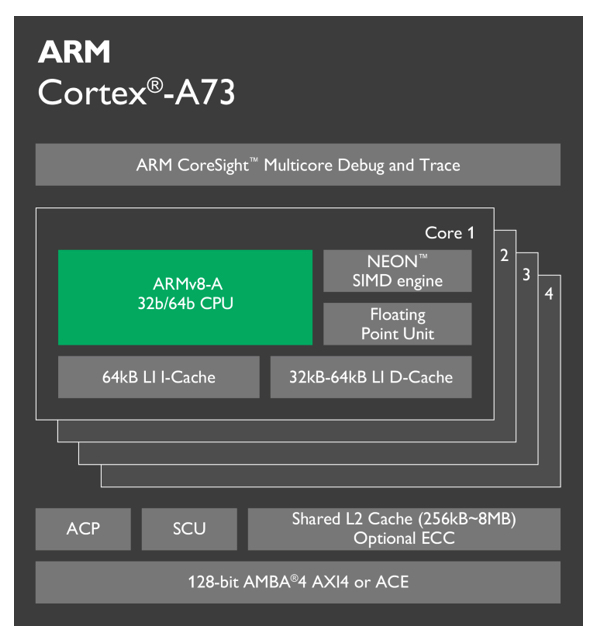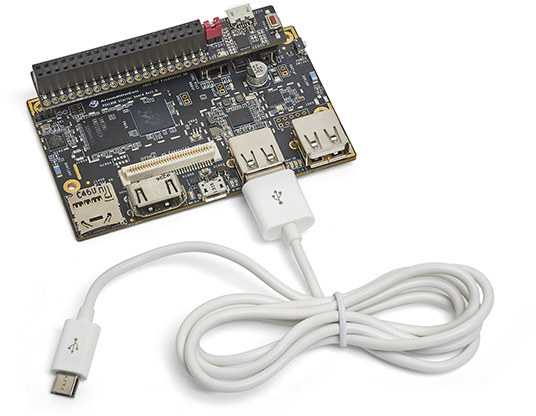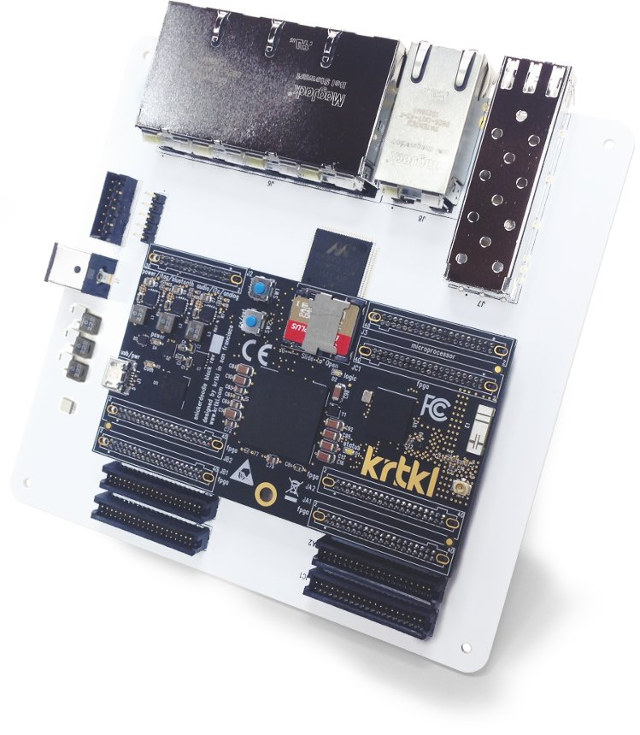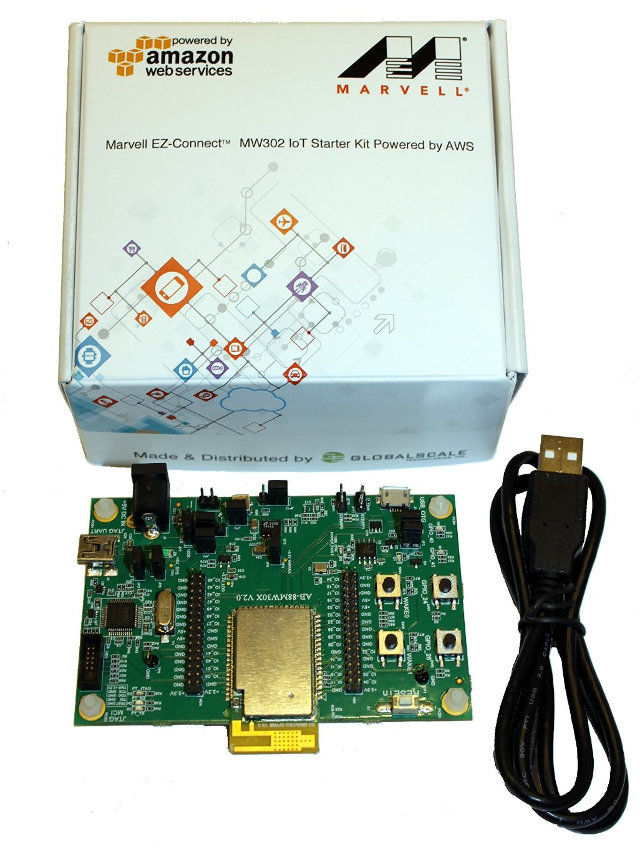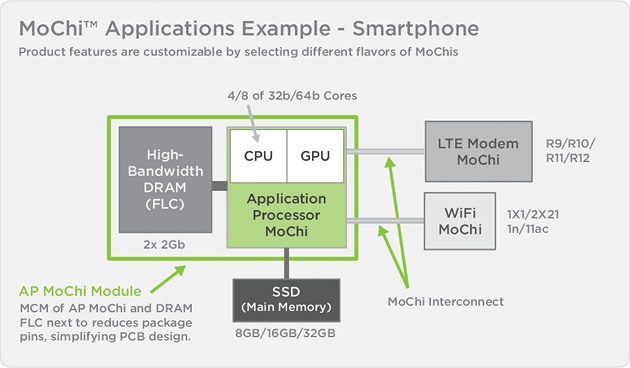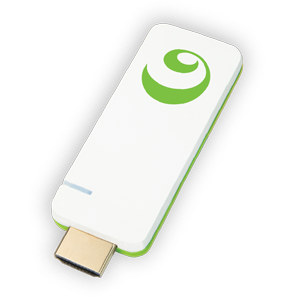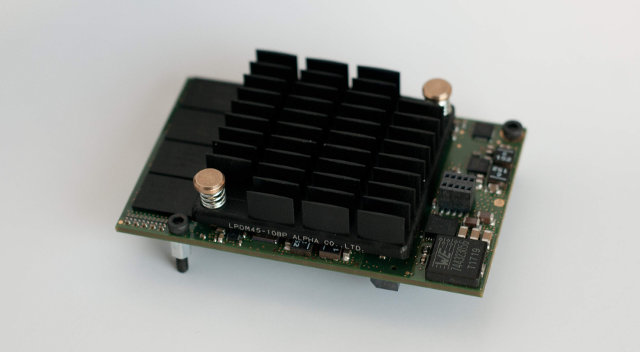Today ARM has revealed the first details of its latest mobile processor and GPU, both said to be optimized for VR (Virtual Reality) and AR (Augmented Reality) applications. Starting with the ARM Cortex-A73, we’re looking at an evolution of the current Cortex-A72 with ARM claiming 30 percent “sustained” performance over the Cortex-A72 and over twice the performance over the Cortex-A57. ARM is already talking about clock speeds of up to 2.8GHz in mobile devices. Other improvements include an increase up to 64k L1 instruction and data cache, up from 48 and 32k respectively for the Cortex-A72, as well as up to 8MB of L2 cache. The Cortex-A73 continues to support ARM’s big.LITTLE CPU design in combination with the Cortex-A53 or the Cortex-A35. It’s also the first ARM core to have been designed to be built using 10nm FinFET technology and it should be an extremely small CPU at around 0.65 […]
AndroMeda Box Edge Brillo Starter Board Features Marvell IAP140 Processor, 96Boards Form Factor
Google announced Brillo, a new operating system based on Android and targeting the Internet of things, at the end of October. The company also disclosed that ARM, MIPS and x86 architectures were supported via respectively TechNexion Pico-i.MX6UL system-on-module and PICO-DWARF baseboard, MIPS Creator CI-40 board, and Intel Edison development board. A few days later, Marvell announced Andromeda Box, an IoT platform supporting Brillo and Weave, based on IAP140, a quad-core ARM Cortex A53 application processor for the “Edge” version, and ARMADA 385 dual core Cortex A9 processor for the “Connect” version, but without the full details. AndroidMeda Box Edge is now listed on Solid Run and Arrow websites, where it is sold for $74.99. If the board looks familiar, it’s because it clearly follows 96Boards form factor, but instead of officially being supported by Linaro, it has been designed specifically as a Google’s Brillo development platform with the following specifications: […]
giggleBits Hackable ARM & FPGA Router Comes with an SFP Cage and 5 Gigabit Ethernet Ports (Crowdfunding)
Remember Snickerdoodle board? If you don’t, the board is one of the cheapest Xilinx Zynq available on the market, and the project is currently on CrowdSupply, and 75% funded with 28 days left. They’ve just posted an update about a new daughterboard that I found interesting: giggleBits which provides 5 Gigabit Ethernet and an SFP cage on top of WiFi 802.11 b/g/n and Bluetooth connectivity already found on Snickerdoodle board. giggleBits + snickerdoodle specifications: SoC/Memory/Storage/WiFi via Snickerdoodle board: SoC Xilinx Zynq-7010 dual core Cortex A9 processor @ 667 MHz + FPGA with 430K gates or Xilinx Zynq-7020 dual core Cortex A9 processor @ 866 MHz + FPGA with 1.3million gates (~430K ASIC gates) System Memory – 512MB or 1GB LPDDR2-800 Storage – micro SD card slot, 16MB boot flash Ti Wilink 8 – single or dual band 802.11 b/g/n WiFi + Bluetooth 4.0 Expansion – 4x 40-pin TFM headers for access […]
Marvell EZ-Connect MW302 IoT Starter Kit Supports AWS IoT Cloud Services
Amazon has just launched AWS (Amazon Web Services) IoT (Beta), a cloud platform that lets connected devices securely interact with cloud applications and other IoT devices. As pasrt of the announcement, they also released AWS IoT SDK that comes in three flavors: Embedded C SDK for C-based platforms such as Linux, RTOS, with variants for OpenSSL and mbed TLS. JavaScript SDK in Node.js Arduino Yún SDK. Ten started kits are currently officially supported by AWT IoT, many of them being existing platforms such as LinkIt One, BeagleBone Green, Intel Edison, or TI LaunchPad CC3200, with several of these kits including SeeedStudio’s Grove modules. One of the kits that’s completely new, at least to me, is Marvell EZ-Connect MW302 IoT Starter Kit which include a mini USB to USB cable, and Marvell 88MW302 development board with the following (preliminary) specifications: SoC – Marvell EZ-Connect MW302 ARM Cortex-M4 WiSoC with 512KB SRAM […]
Marvell Announces AP806 Cortex A72 & ARMADA A3700 Cortex A53 Virtual SoCs based on MoChi & FLC Architecture
Marvell has published a press release introducing AP806 quad core Cortex A72 and ARMADA A3700 dual and single core Cortex-A53 chips. But these two chips are called Virtual SoCs (VSoC) and they are said to use MoChi and FLC (Final Level-Cache) architecture. What does this all means? If I understand correctly, Marvell has decided to create modular SoCs that may just integrate the minimum: CPU, GPU, and memory controller, with other peripherals like Ethernet, SATA, LTE Modem added to the virtual SoC in some ways just like legos. This is done in order to mitigate the cost of manufacturing chips with advanced process nodes (e.g. Finfet 16) with usually has high steep mask costs, and wafer prices. So they may have a single AP806 MoChi module, to create multiple SoCs using different MoChi modules to add peripherals. Marvell listed some of the key befinits of modular SoCs: Changing existing software […]
Kinoma HD is $25 TV Stick Devkit Based on Marvell ARMADA 1500 Mini Plus Processor
Marvell has just revealed that ChromeCast 2.0 & Audio featured their ARMADA 1500 Mini Plus (88DE3006) processor with two ARM Cortex A7 cores, coupled with 512 MB RAM, and Avastar 88W8887 wireless solution with WiFi 802.11 b/g/n/ac, Bluetooth 4.1, NFC and FM radio. But a comment on Anandtech lead me to a development kit based on 88DE3006 I missed while I was away: Kinoma HD. Preliminary hardware specifications: SoC – Marvell ARMADA 1500 Mini Plus (88DE3006) dual core Cortex A7 @ 1.2 GHz with 3D GPU supporting OpenGL ES 1.1/2.0, Qdeo video engine System Memory – 256 MB RAM Storage – TBD Video Output – HDMI output of 1080p/720p Connectivity – Wi-Fi g/n/ac Power Supply – 5V via micro USB port Apart for the lower memory capacity (256MB vs 512MB), Kinoma HD hardware looks pretty similar to ChromeCast 2.0. But the main difference is in the software, as while ChromeCast […]
Linaro 15.07 Release with Linux 4.2 and Android 5.1
Linaro 15.07 has been released with Linux 4.2-rc3 (Baseline), Linux 3.10.83, 3.14.45 and 3.18.17 (LSK), and Android 5.1.1_r8. The Linux kernel got various bug fixes, and a power reduction technique has been implemented for Qualcomm processor. Progress has been made to boot Android with UEFI on Hikey board, and work is still on-going on 96boards including Hisilicon Hikey, Qualcomm DragonBoard 410c, and an upcoming and yet-to-be-formally-announced Marvell PXA1928 board called Helium. Highlights of this release: Linux Linaro 4.2-rc3-2015.07 linaro-android topic updated to 4.2-rc3 and recent AOSP/android-3.18 included GATOR version 5.21.1 llct-misc-fixes topic: “HACK: of: Limit FDT size for CRC check on arm64” has been dropped. FVP model was the last target to require this hack, but the new FVP firmware doesn’t need it anymore updated integration-linaro-vexpress64 topic by ARM LT: Versatile Express TC2 support is back, HDLCD display now works on TC2, the topic will be renamed to integration-linaro-vexpress next […]
Iliad’s Online Labs Offers Quad Core ARMv7 Dedicated Servers
Iliad (Free) is a French company known to bring the price of technology down for the masses. Several years ago, they disrupted the Internet broadband market, by bringing low cost triple play broadband services to market, and more recently they entered the mobile market with 2 Euros 3G/4G monthly subscriptions. The company also owns Online.net providing hosting services, and which has recently launched a public preview for Online Labs cloud platform. Most hosted solutions nowadays relies on x86 servers and virtualization, but Online Labs instead features dedicated physical ARM servers connected to SSDs. The company call their custom-made credit-card size server modules C1 boards, completely unrelated to ODROID-C1 boards, as those are powered by a quad core ARMv7 Marvell processor with 2GB RAM, and a 1Gb/s network interfaces. These are then assembled into racks as shown below. And finally 16 racks are inserted into a chassis with a control board, […]


